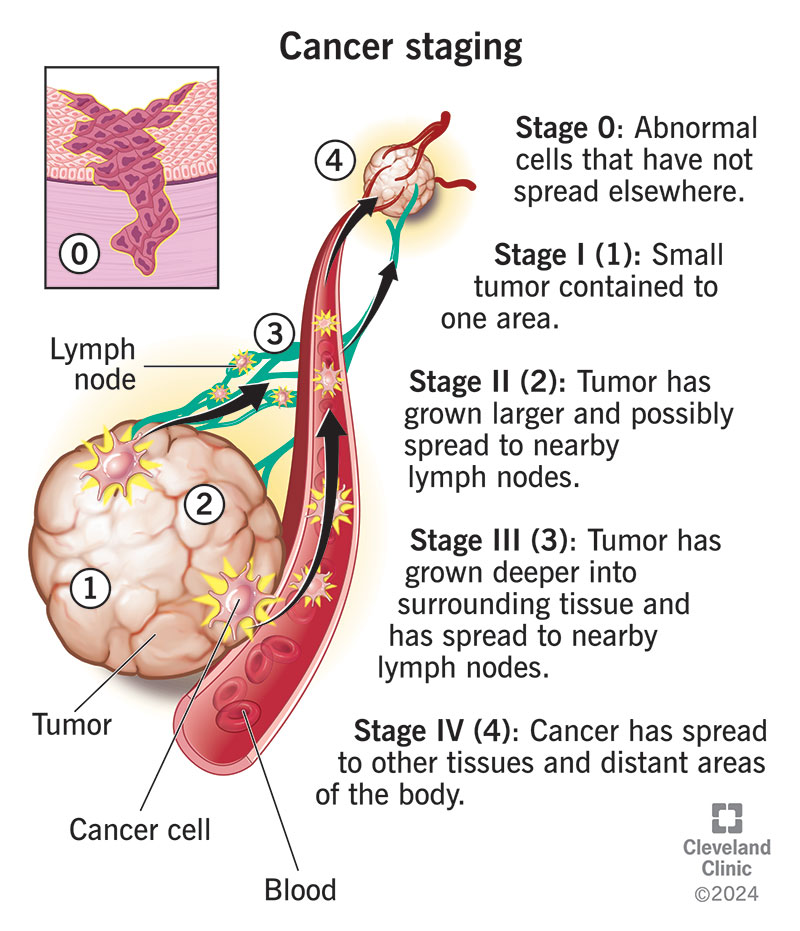Healthcare providers use stages of cancer to diagnose disease, make treatment plans and collaborate with other cancer specialists. They base cancer staging on different factors, like tumor size, location and whether cancer cells have spread to other areas of your body. Your provider can help you understand cancer staging and what it means for you.
Advertisement
Cleveland Clinic is a non-profit academic medical center. Advertising on our site helps support our mission. We do not endorse non-Cleveland Clinic products or services. Policy

Cancer staging is a way to measure the extent of cancer in your body. Oncologists use it for diagnosis and treatment. Cancer staging also helps researchers measure treatment patterns and outcomes. Sharing, tracking and reporting these findings helps the global medical community work together for potential cures.
Advertisement
Cleveland Clinic is a non-profit academic medical center. Advertising on our site helps support our mission. We do not endorse non-Cleveland Clinic products or services. Policy
It’s easy to feel intimidated by a system that describes your illness with a formula of letters and numbers. Healthcare providers understand why you might feel this way. They’ll take time to explain the cancer staging system and what it means for you.
Healthcare providers stage cancer for several reasons:
Advertisement
When healthcare providers stage cancer, they focus on factors like:
Healthcare providers might use one or more cancer staging systems to diagnose or treat your condition. Below are some of the numbers, letters and descriptions you might see, including a summary of what they mean.
Healthcare providers use a number system to stage most cancers. The stages of cancer are:
Healthcare providers rarely use stage V (5) classification. Wilms tumor is one exception. It’s a childhood cancer that starts in the kidneys. Stage 5 Wilms tumors affect both kidneys.
Sometimes, healthcare providers divide each numeric stage even further into categories A, B, C or D. For instance, your oncologist might say you have stage IIA (2A) or IIIB (3B) cancer. These letters offer more insight into your diagnosis.
Generally, A describes less aggressive (slower growing) cancers, while D describes more aggressive (faster growing) cancers within each numeric stage. That means a IIA cancer is less aggressive than a IIB cancer. But a IIIA cancer is more aggressive than a IIB cancer.
Healthcare providers may also refer to cancer stage by location:
Tumor, node, metastasis (TNM) is a common system providers use to describe the spread of cancer:
Advertisement
TNM can stage solid tumors like breast and colon cancers, but not blood cancers like leukemia or lymphoma.
Healthcare providers may use other staging systems to diagnose some cancers. One example is the Lugano system for staging Hodgkin lymphoma and non-Hodgkin lymphoma. Another example is the FIGO system, which providers use to diagnose some cancers of the female reproductive system.
Asking your oncologist which staging system(s) they use can help you gain a fuller understanding of your cancer diagnosis.
Healthcare providers stage cancer by doing physical examinations and tests like:
Advertisement
Contrary to what you might think, your cancer stage won’t change after your diagnosis, even if it spreads or goes into remission later.
For example, if you had stage II (2) cancer at the time of your diagnosis, you’ll always have stage II cancer. Your provider will just use additional classification terms to describe any changes:
Having cancer is stressful. A formulaic diagnosis of letters and numbers can add to your feelings of anxiety and uncertainty. But there’s more to a cancer stage than a formulaic name. Healthcare providers use stages to create treatment plans, collaborate with others and develop a prognosis so you know what to expect. Your healthcare provider is here to help. They can answer any questions you have about your specific cancer stage.
Advertisement
When you’re diagnosed with cancer, you want expert and compassionate care right away. At Cleveland Clinic we personalize your treatment to match your needs.

Last reviewed on 08/05/2024.
Learn more about the Health Library and our editorial process.